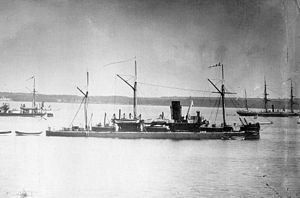Name Admiral Lazarev Ordered 24 May 1865 Laid down 29 May 1867 Launched 21 September 1867 | Cost 1,289,300 rubles Construction started 29 May 1867 | |
 | ||
Builder Carr and MacPherson, Saint Petersburg | ||
The Russian monitor Admiral Lazarev was the name ship of her class of monitors built for the Imperial Russian Navy in the late 1860s. She was assigned to the Baltic Fleet upon completion and remained there for her entire career. Aside from one accidental collision, her service was uneventful She was reclassified as coast-defense ironclad in 1892 before she became a training ship later that decade. Admiral Lazarev was stricken from the Navy List in 1907 and sold for scrap in 1912. She sank while under tow to Germany later that year.
Contents
Design and description
The Admiral Lazarev-class monitors were significantly larger than their predecessors, the Charodeika class, and had an overall length of 262 feet (79.9 m), a beam of 43 feet (13.1 m) and a maximum draft of 21 feet (6.4 m). The ships were designed to displace 3,505 long tons (3,561 t), but turned out to be overweight and actually displaced 3,820 to 3,881 long tons (3,881 to 3,943 t). They were fitted with a plough-shaped ram. The Admiral Lazarevs had a double bottom and their hulls were subdivided by six main watertight bulkheads. Their crew consisted of 269–74 officers and crewmen. The Admiral Lazarev-class ships had a single two-cylinder horizontal direct-acting steam engine that drove a single propeller, using steam provided by four rectangular fire-tube boilers. The engine was designed to produce a total of 2,020 indicated horsepower (1,510 kW) which gave the ships speeds between 9.54–10.4 knots (17.67–19.26 km/h; 10.98–11.97 mph) when they ran their initial sea trials in 1871. The Admiral Lazarev class carried 260 long tons (264 t) of coal which gave them a range of about 1,200–1,500 nautical miles (2,200–2,800 km; 1,400–1,700 mi) at a speed of 9 knots. They were fitted with a light fore-and-aft sailing rig to steady her and aid in maneuvering.
Armament
The monitors were ultimately designed to be armed with six 20-caliber Obukhov 11-inch (279 mm) rifled muzzle-loading guns, a pair in each Coles-type turret. Around 1874–75 the guns were replaced by three 11-inch (279 mm) guns, based on a Krupp design. During the Russo-Turkish War of 1877–78 a 9-inch mortar was fitted to attack the thin deck armor of enemy ships, but accuracy was poor and they were later removed, probably in the early 1880s. An improved, more powerful, 22-caliber 11-inch gun was installed aboard the sister ships during the 1880s.
Light guns for use against torpedo boats were added to the Admiral Lazarev class during the Russo-Turkish War when a pair of 4-pounder 3.4-inch (86 mm) guns were mounted on the roofs of the fore and aft gun turrets and a 44-millimeter (1.7 in), 4-barreled Engstrem quick-firing (QF) gun. By the early 1890s, the light armament consisted of one or two 2.5-inch (64 mm) Baranov QF guns, five 47-millimeter (1.9 in) QF Hotchkiss guns, replacing the 4-pounders, and a pair of 37-millimeter (1.5 in) QF Hotchkiss five-barreled revolving cannon. The ships could also carry 12-15 mines intended to be used to create a secure anchorage.
Armor
The hull of the Admiral Lazarev-class monitors was completely covered by wrought iron armor that 4–4.5 inches (102–114 mm) thick amidships and thinned to 3 inches (76 mm) aft and 3.5 inches (89 mm) forward of the main belt. The turrets had 6 inches (152 mm) inches of armor, except around the gun ports, where it thickened to 6.5 inches (165 mm). The conning tower was 5 inches (127 mm) thick and the deck armor was in two layers with a total thickness of 1 inch.
